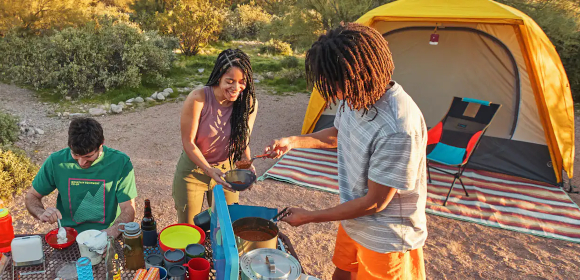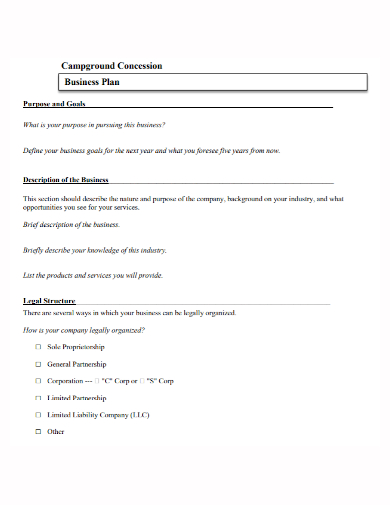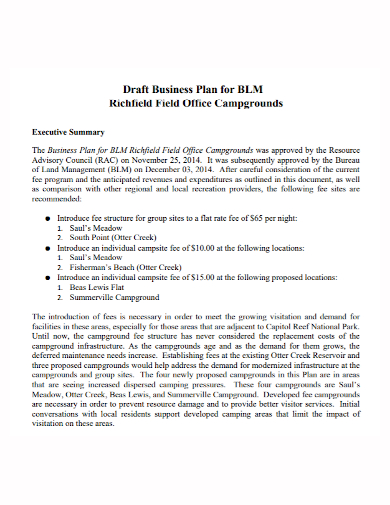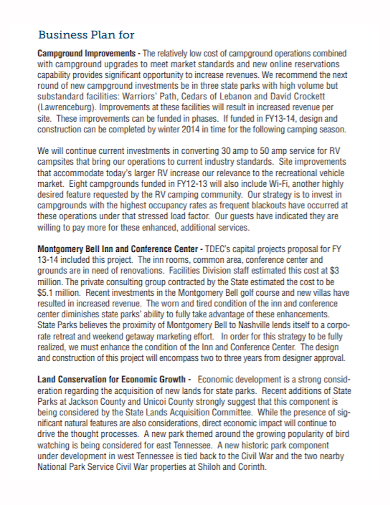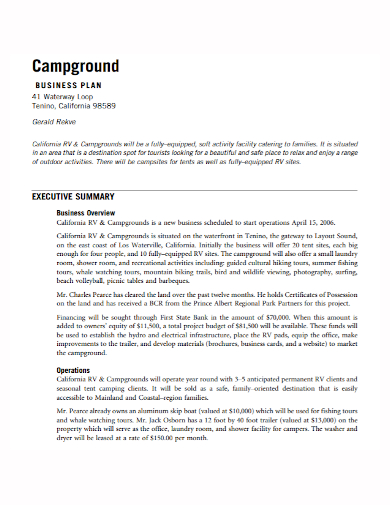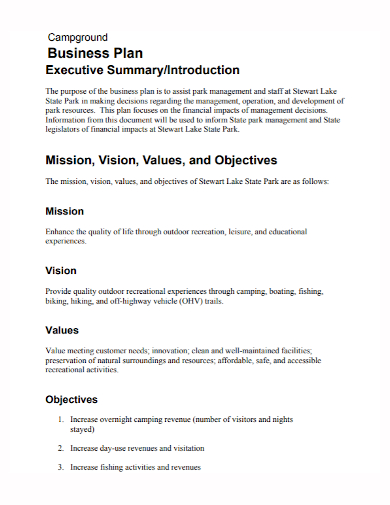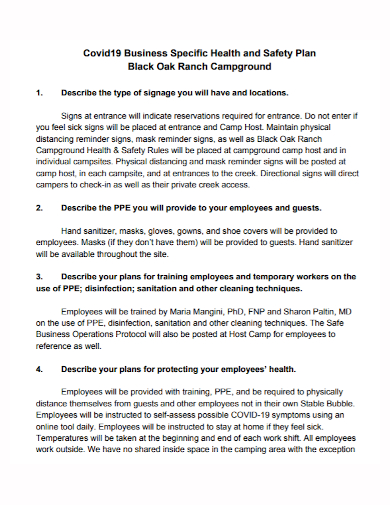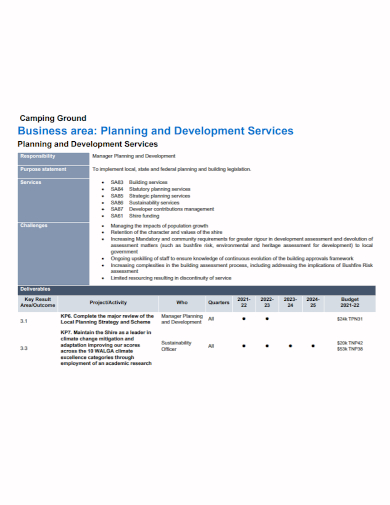Camping is one of the most fun hobbies to do for people to seek adventure, be closer to nature, unwind from the hustle and bustle of city life, and find tranquility in mountains or in the woods. Camping is also a great experience for everyone, especially kids, to learn new skills such as surviving in the wild without the comforts of modern technology and doing rigorous activities to keep them fit and healthy. If you’re more than just a camping enthusiast and have the qualifications to train for survivalist and camping living and your experience with nature and you own a piece of land in the woods that you want to convert into a camping ground, one of the first things you need to do is to make a business plan. Read the article to know how to make one.
10+ Camping or Camp Ground Business Plan Samples
1. Camping or Camp Ground Business Plan Template
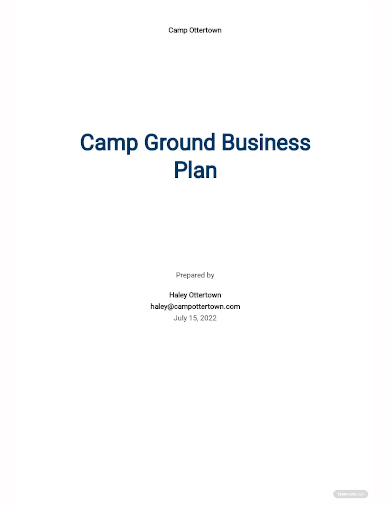
2. Camp Ground Concession Business Plan
3. Office Camp Ground Business Plan
4. Camp Ground Operating Business Plan
5. Camp Ground Improvements Business Plan
6. Camp Ground Summary Business Plan
7. Sample Camp Ground Business Plan
8. Standard Camp Ground Business Plan
9. Basic Camp Ground Business Plan
10. Camp Ground Business Safety Plan
11. Camp Ground Development Business Plan
What Are the Benefits of Camping?
- You get to enjoy peace and quiet: You have the opportunity to unplug from your devices and enjoy the simplicity of nature and live in the moment.
- You get to exercise more: Since camping requires you to do physical activities such as setting up and managing your shelter, hiking to your trail, fishing, swimming, or even riding bikes, you get to do cardiovascular exercises which will help you lose weight and maintain a healthy body.
- It reduces stress: City life can be taxing and stressful and getting away from the pressure and pollution and going back to nature helps you calm yourself and your body releases high levels of serotonin; a neurotransmitter in your body that helps regulate your mood, appetite, and sleep which will help you recharge your inner psyche.
- Improve relationships: Camping is a great way to connect and socialize with your friends and family and share experiences together through camaraderie and you all can enjoy and have fun.
Details to Include in a Camping Ground Business Plan
1. Cover Sheet and Executive Summary
Start your business plan with a cover sheet. At the top of the page, put the title of the business plan, then put your camp name, address, date, and your name as the owner.
The next section is your executive summary. The summary must only be one page in length. It should provide an overview of your business plan and highlight only the most important components.
2. Background of the Camp
This section is where you will explain what your camp is all about. Include the following infomration in your background section:
- Purpose of the camp
- Location of your camp
- Mission statement
- Long-term goals for your camp
- Legal structure of the camp
- History of the camp
3. Programs and Activities Offered
Hype your readers by showing them what makes your camp ground awesome. List all the programs and activities you offer to your campers. Some common yet fun camping activities examples are hiking, swimming, kayaking, wildlife watching and photography, balancing rocks, crafting arts, scavenger hunting, stargazing, storytelling around the campfire, making smores, and singing and playing instruments. Explain in great detail all of these. Make sure to have an upbeat tone when describing these programs.
To further hook your readers to stay interested in your camp, provide photos of your camping ground. This will visualize what you camp looks like and how fun the acitivies you do.
4. Competitive Analysis
The competitive analysis is where you include your research about your competition. Include brief details about them and using that information, explain why people should go to your camp, what programs differentiate you from other camps, and how your pricing is more attractive to campers.
5. Organizational Structure
In this section, include details about your staff such as their name, experience, and qualificiations in running a camp ground. Include an organization chart where you show each staff’s responsibilties and to whom do they report to.
6. Operations Plan
Include a detailed plan of your day-to-day operations. Explain how your camp function such as its registration, maintenance, food service, planning for programs and activities, annual assessment of your camp operations, procurement of camp equipment and other behind-the-scenes components of your business.
Describe also the equipment, materials, and facilities you use in your camp ground such as its location, size, type of living units, program facilities, meeting and dining spaces, natural features, and any other areas at your camp.
7. Risk Management
Working close to nature can also present more risks compared to other business. You must include your plan on assessing and managing risks that may happen to campers such as injuries, weather or other natural occurrences, and even financial risks. Give details on how you will address these risks and create an action plan to use as your guidance in risk assessment and management.
8. Marketing Plan
Outline your marketing plan to promote your camp ground to the public. Identify your marketing strategies thatwill appeal campers to choose your camp to stay in.
9. Financial Plan
Your financial plan must include all important information on your finances and how you manage them. Include the following information such as your current capital, profit and loss statement, break-even analysis, projected cash flow, projected balance sheet, and business ratio. Explain how you came up with these projections. Point out which data is your actual finances and which is projected.
FAQs
How much do camping fees cost?
Camping fees are usually present in established campgrounds or national parks. On average, campsite fees cost around $10-25. Group campsites cost much more at around $65-$80.
What are the different types of camping?
Camping can come in various types. Whatever camping types you follow, you’re sure to have fun and adventure doing them The different types of camping are:
- Tent camping
- Hiking
- Survivalist camping
- Canoe camping
- RV or van camping
- Winter camping
- Glamping
How much does a campsite make?
The income a campsite can make varies greatly based on the average number of campers they have annually and the fees you’ve established for every camper. Some campsites make around $200,000 and up annually.
A business plan will take some time to write, but all the effort in doing it is worth the effort. Make sure your plan is interesting enough to read and at the same time, all the information in it is accurate. To help you get started on writing a business plan for your camp ground, download our free sample templates provided above to use as your reference!
Related Posts
FREE 9+ 30-Day Marketing Plan Samples in PDF | MS Word | Apple Pages | Google Docs
FREE 3+ Sales Team Action Plan Samples in PDF | MS Word | Apple Pages | Google Docs
Marketing Plan For Small Business Samples
FREE 7+ Fashion Business Plan Samples in PDF
FREE 10+ Sprint Planning Samples In MS Word | Google Docs | PDF
FREE 10+ Wedding Planning Samples in MS Word | Apple Pages | Powerpoint | PDF
FREE 9+ Monthly Study Planner Samples in PSD | Illustrator | InDesign | PDF
FREE 9+ Sample Curriculum Planning Templates in PDF | MS Word
FREE 10+ Teacher Development Plan Samples in MS Word | Google Docs | Apple Pages | PDF
FREE 10+ Basketball Practice Plan Samples in PDF
FREE 12+ School Business Plan Samples in PDF | MS Word | Apple Pages | Google Docs
FREE 7+ Client Strategic Plan Samples in PDF | MS Word
FREE 11+ Trucking Business Plan Templates in PDF | MS Word | Google Docs | Pages
FREE 7+ Small Hotel Business Plan Samples PDF | MS Word | Apple Pages | Google Docs
FREE 14+ Bakery Business Plans in MS Word | PDF | Google Docs | Pages
